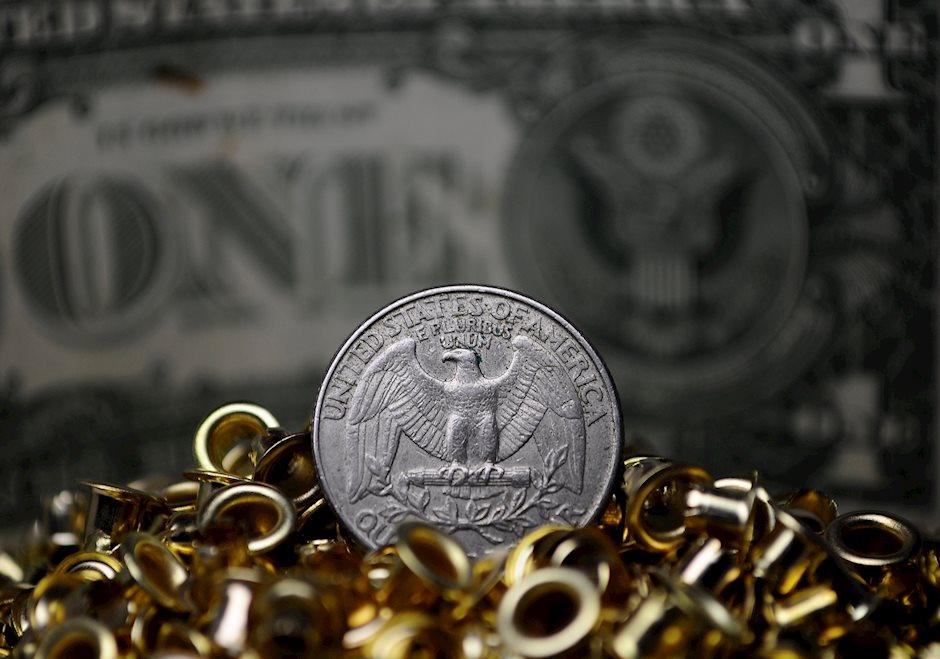US Dollar creates the first wave in markets for this year after hot CPI print
- The US Dollar rallies with inflation coming in red hot again.
- Traders are writing off three cuts for 2024 and now only see two.
- The US Dollar Index shoots through the roof and makes its way towards 105.00.

The US Dollar (USD) is being bought, that much is clear after the recent US Consumer Price Index (CPI) print. with all numbers coming in at the high end of expectations, there is no more doubt that June is now off the table for a first cut from the US Federal Reserve. Markets are even going further and are fully pricing out three, down to two rate cuts.
Pressure is now on for later this Wednesday with the US Federal Reserve Minutes release. Markets could start to build up more stance in disbelief of the Fed, should the Minutes be as dovish as Fed Chairman Jerome Powell was in his latest speech. This could make markets think the Fed is facing a policy mistake, with US Dollar set to rally further over a longer period of time.
Daily digest market movers: Ouch, hot inflation coming in
- At 11:00 GMT, this eventful Wednesday will kick off with the Mortgage Bankers Association (MBA) numbers. The MBA Mortgage Applications for the week ending on April 5 came in at 0.1% from -0.6% last week.
- At 12:30 GMT, the US Consumer Price Index for March was released:
- Monthly headline inflation came in unchanged at 0.4%
- Yearly headline inflation accelerated from 3.2% to 3.5%.
- Monthly core inflation was unchanged at 0.4%.
- Yearly core inflation was stable at 3.8%.
- At 14:00 GMT, Wholesale Inventories data for February will be released, with a steady 0.5% increase expected.
- Federal Reserve Bank of Chicago President Austan Goolsbee will be speaking around 16:45 GMT.
- The Federal Open Market Committee (FOMC) will release its recent March meeting Minutes around 18:00 GMT. Traders will be looking for clues or clearer evidence for the timing of when the Fed will start cutting its interest rates.
- Equities in both Europe and the US are not enjoying the kick in the nuts from the Greenback. All indices are down over 1% on the day.
- According to the CME Group’s FedWatch Tool, expectations for the Fed’s May 1 meeting are at 97.4% for keeping the fed funds rate unchanged, while chances of a rate cut are at 2.6%.
- The benchmark 10-year US Treasury Note trades around 4.48%, highst in months.
US Dollar Index Technical Analysis: finally things are moving
The US Dollar Index (DXY) has been consolidating since the first days of 2024. Although the trading range looks to be around 5% from the beginning of this year, it has been even limited to only 3% most of the time. Volatility is nowhere and short-lived, if any, so this US CPI print on Wednesday is crucial as it could be the last possible data point confirming if the Fed is good to start reducing borrowing costs in June, or might not cut rates until after summer or not at all for 2024.
The first pivotal level for the DXY comes in at 104.60, which was broken last week on Wednesday to the downside, though broken up again from below on Friday. Further up, 105.12 is the key point after the DXY failed to break that level last week. Once above those levels, 105.88 is the last resistance point before the Relative Strength Index (RSI) enters overbought levels.
Support from the 200-day Simple Moving Average (SMA) at 103.81, the 100-day SMA at 103.43, and the 55-day SMA at 103.90 showed their importance last week on Wednesday. Further down, the 103.00 big figure looks to remain unchallenged for longer with ample support thus standing in the way.
US Dollar FAQs
The US Dollar (USD) is the official currency of the United States of America, and the ‘de facto’ currency of a significant number of other countries where it is found in circulation alongside local notes. It is the most heavily traded currency in the world, accounting for over 88% of all global foreign exchange turnover, or an average of $6.6 trillion in transactions per day, according to data from 2022. Following the second world war, the USD took over from the British Pound as the world’s reserve currency. For most of its history, the US Dollar was backed by Gold, until the Bretton Woods Agreement in 1971 when the Gold Standard went away.
The most important single factor impacting on the value of the US Dollar is monetary policy, which is shaped by the Federal Reserve (Fed). The Fed has two mandates: to achieve price stability (control inflation) and foster full employment. Its primary tool to achieve these two goals is by adjusting interest rates. When prices are rising too quickly and inflation is above the Fed’s 2% target, the Fed will raise rates, which helps the USD value. When inflation falls below 2% or the Unemployment Rate is too high, the Fed may lower interest rates, which weighs on the Greenback.
In extreme situations, the Federal Reserve can also print more Dollars and enact quantitative easing (QE). QE is the process by which the Fed substantially increases the flow of credit in a stuck financial system. It is a non-standard policy measure used when credit has dried up because banks will not lend to each other (out of the fear of counterparty default). It is a last resort when simply lowering interest rates is unlikely to achieve the necessary result. It was the Fed’s weapon of choice to combat the credit crunch that occurred during the Great Financial Crisis in 2008. It involves the Fed printing more Dollars and using them to buy US government bonds predominantly from financial institutions. QE usually leads to a weaker US Dollar.
Quantitative tightening (QT) is the reverse process whereby the Federal Reserve stops buying bonds from financial institutions and does not reinvest the principal from the bonds it holds maturing in new purchases. It is usually positive for the US Dollar.
Author

Filip Lagaart
FXStreet
Filip Lagaart is a former sales/trader with over 15 years of financial markets expertise under its belt.

















